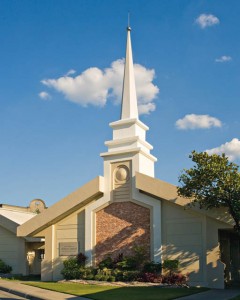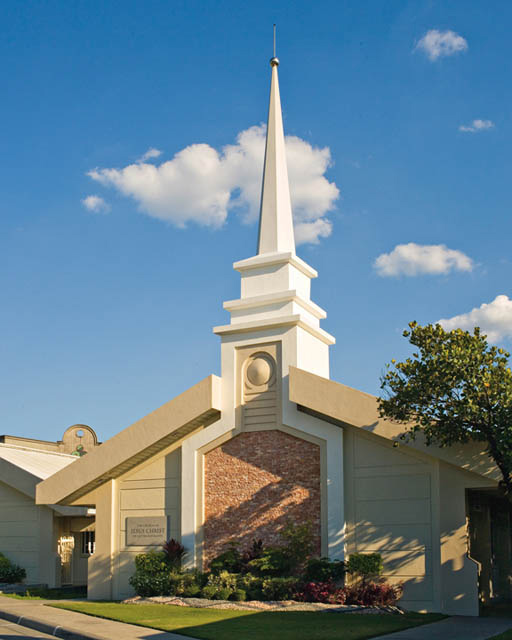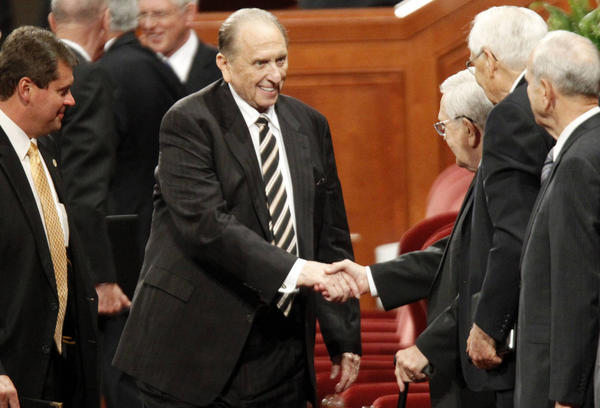Have you ever wondered what the inside of a Mormon church building looks like? You are invited to a virtual tour on an official Mormon website. Open it in another window so you can look around while reading my more detailed information here.
Take a virtual tour of a Mormon meetinghouse.
Each Mormon meetinghouse contains a large number of classrooms in various sizes. You’ve already seen the Relief Society and Primary. Today, we’ll visit a smaller classroom. On the map below the video, you’ll see a foyer. To the right of the foyer is an unlabeled silver dot inside a small room. Click the dot. This takes you to a classroom.
 The classroom is very simple and undecorated, so it can be used by more than one class if needed. Teachers generally bring their own decorations each week, normally pictures or items related to the lesson, so nothing distracts from the topic. The room includes little more than a magnetized chalkboard, chairs suited to the ages of the students, a teacher’s chair, and a small table where the teacher can place her materials.
The classroom is very simple and undecorated, so it can be used by more than one class if needed. Teachers generally bring their own decorations each week, normally pictures or items related to the lesson, so nothing distracts from the topic. The room includes little more than a magnetized chalkboard, chairs suited to the ages of the students, a teacher’s chair, and a small table where the teacher can place her materials.
The teacher begins and ends class with a prayer. He or she teaches from a lesson manual prepared by the church, generally following a schedule. In most classes, you could show up in any church building and find the class exactly where your own class left off. This allows for continuity for travelers.
The teacher is always a volunteer. The Mormons have a lay church and there is enough work in their complex programs to keep everyone busy who wants a calling, as unpaid church jobs are known.
Read the lesson manuals taught by Mormons. The lesson manuals are available on the church website for anyone to read. This can be a good way to find out what Mormons teach members each week.
Let’s look at a sample lesson to see how a typical class might operate. We’ll use the following lesson:
Coming To Know the Savior
This lesson was written for girls ages twelve to seventeen. They are usually taught in classes containing two age groups (12-13, 14-15, 16-17) and the lessons are adapted to the ages of the students. Each manual is taught twice, the second time at a more adult level, since the girls are now older. Two adult teachers, a member of the presidency and the class advisor, are present in each class. In the Young Women’s classes, all teachers and leaders are women. In the Young Men’s classes, all leaders and teachers are men. Sunday School is taught in mixed gender classes and the teacher may be either gender.
As you can see, the manual is designed so even an experienced teacher will be able to present an interesting and age-appropriate lesson. The teacher is encouraged to pray to determine the individual needs of her specific students as she prepares.
Each lesson offers an objective. This helps the teacher remain focused as she teaches. For this lesson, the objective is to help each young woman become a friend of Jesus Christ.
The lesson uses standard methods for quality teaching. To focus the girls’ attention on the topic, the teacher tells a story that helps them to understand knowing about Jesus is not the same as knowing Him. She then gives them a moment to contemplate where they stand in this story and then guides them through a discussion. A picture of Jesus knocking at a door is shown to end the discussion and return them to the topic. If you examine the picture carefully, you discover there is no doorknob. The message is that Jesus cannot enter your life unless you let Him in.
The girls are led through a variety of scriptures to help them learn more, which teaches them to turn to the Bible and other scriptures for gospel knowledge. They are also taught stories from the lives of church leaders and read the counsel of leaders to them, including this counsel, originally given to adult men:
“He wants us to come to him as we are. We do not have to be perfect to go to him. While Jesus was on the earth he associated with publicans and sinners and his disciples asked him why he associated with them, to which question Jesus gave a beautiful and simple answer: ‘They that are whole have no need of the physician, but they that are sick.’ (Mark 2:17.) The Lord does not ask us to heal ourselves of our imperfections before we approach him, but to come to him with those imperfections and he will assist us in overcoming them. The Lord loves us and wants us to overcome our sins and he will help us as we exercise our free agency. We must initiate the process of repentance and strive with all of our might to overcome our weaknesses” (Gospel Doctrine [A Course of Study for the Melchizedek Priesthood Quorums, 1970–71], p. 57).
The teacher then guides the girls through the process of reflecting on what they’ve learned so far to create a list of things they can do to draw closer to Jesus Christ. By developing this list themselves from the materials, they learn how to apply the lessons they learn to their personal lives, a skill which will help them throughout their lives.
The lesson concludes with testimonies from the teacher and classmates about the topic of the lesson, allowing the girls to learn from each other.
This lesson is typical of those taught at any age. Naturally, lessons for children include flannel board stories, puppets, and games, and adults might read more scriptures, but generally, students are taught basic principles of truth and then guided to apply them to their lives.
Teenagers probably receive more instruction than any other group. They have two Sunday classes. In addition, they have a weekday religion class taught during the school year. Most students attend this class, called Seminary, early in the morning. It involves an in-depth study of the scriptures for four years. Two of these years focus on the Bible. Once a week, they meet in the evening for a youth group meeting, which usually involves putting the gospel into action through service projects, learning practical skills, or educational but fun activities. The boys do Boy Scouts of America some weeks, while the girls have a similar program called Personal Progress.
In addition to all of these, they have an annual youth conference over two or three days and a summer camp. The teenage years are perilous, and Mormon youth are given a great deal of support to get through them.
In an earlier article, we learned the women spent the last class session in Relief Society. The men, during the same time, are attending their priesthood quorums, learning most of the same lessons, but focused on their roles as husband, fathers, and priesthood holders. Between the basic service and these gender-specific meetings is Sunday School, held in mixed gender classes for everyone ages twelve and older. Teenagers have their own classes. People who are visiting the church and are not members, or who are new members have a class of their own called Gospel Principles. This teaches them the essential aspects of the gospel at a beginner’s level, so they are prepared to understand the regular class after one year.
The adult Sunday School class is called Gospel Doctrine. A different book of scripture is studied each year in a four year rotation, on the same schedule as the teenagers and older children. Two years are devoted to a study of the Bible. One year is given to the Book of Mormon. The final year is spent on the Doctrine and Covenants, a book of modern revelation, and is combined with church history.
As you can see, Mormon churches are a busy place on Sunday. Of course, gospel study is not just for church meetings. Each member continues to study at home as well, because Mormonism is not a Sunday-only religion.
About Terrie Lynn Bittner
The late Terrie Lynn Bittner—beloved wife, mother, grandmother, and friend—was the author of two homeschooling books and numerous articles, including several that appeared in Latter-day Saint magazines. She became a member of the Church at the age of 17 and began sharing her faith online in 1992.





